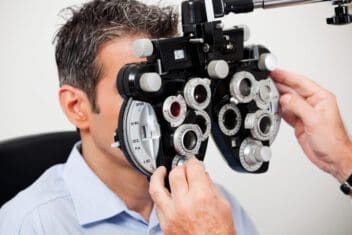
Medically Reviewed by Salwa Aziz, M.D., M.P.H. NVISION Surgeon
How to Spot the Early Signs of Glaucoma
Home / Diagnosed With Glaucoma /
Last Updated:

Medically Reviewed by Salwa Aziz, M.D., M.P.H. NVISION Surgeon

Article At a Glance
Glaucoma often develops without symptoms, but early warning signs can include blurry vision, eye pressure, halos around lights, and blind spots in your side vision. Sudden symptoms—like severe eye pain or nausea—may indicate acute glaucoma, which is a medical emergency.
Regular eye exams are the best way to catch glaucoma early, especially if you have risk factors like age, family history, or diabetes. Early detection allows for effective treatment to slow or prevent vision loss.
Table of Contents
Glaucoma is an eye disease that is the number one cause of blindness for adults over the age of 60, although it can impact people at any age.
There are very few early warning signs for glaucoma. The best way to know if you have it is to get regular eye exams.
Several factors, such as family history, can increase your risk for glaucoma. In order to prevent and minimize your risk for vision loss, you will need to keep the pressure in your eyes down.
Once glaucoma is diagnosed, there are many successful treatment methods for slowing and even stopping the progression of the disease.
Recognizing Glaucoma

Glaucoma is a progressive eye disease that has very few early warning signs, but without treatment, it can lead to blindness.
The disease occurs when the pressure in the eye (intraocular pressure) gets too high and damages the optic nerve. This can lead to vision loss and eventually blindness.
You deserve clear vision. We can help.
With 135+ locations and over 2.5 million procedures performed, our board-certified eye surgeons deliver results you can trust.
Your journey to better vision starts here.
The most common form of glaucoma, open-angle glaucoma, has no symptoms prior to peripheral vision loss most of the time. You may also experience patchy vision or blind spots. Generally, the early signs of glaucoma are not apparent until irreversible vision loss has taken place.
What Is Usually the First Sign of Glaucoma?
Optic nerve damage is often an early indicator of glaucoma, though it usually goes unnoticed until detected during specialized tests at the doctor’s office.
One common test is an eye-pressure check.
Another potential sign of glaucoma is the presence of blind spots in your vision. Eye doctors take blind spots seriously, regardless of the cause, so it’s essential to have them thoroughly evaluated.
Symptoms of Pigmentary Glaucoma
When the material that colors your iris (pigment) rubs off the back of the iris, you may develop pigment dispersion syndrome (PDS). This condition can trigger eye pressure issues, causing pigmentary glaucoma.
If you have pigmentary glaucoma, you may experience blurred vision or see halos during physical activity (running, biking, doing weekend warrior chores, etc.). This is another red flag, so you’ll want to set up time to see your eye specialist as soon as possible.
Diagnosing Glaucoma
The best way to spot glaucoma early on, and therefore start treatment to stop or slow the progression of the disease, is through regular eye exams.
The Eye Pressure Test (Tonometry)
To determine if your eye pressure is within the normal range, your optometrist may use a test called tonometry. The process typically involves:
- Administering dye and numbing drops to your eye
- Shining a light into your eye
- Gently touching the front of your eye with a tonometer to measure the pressure
Tonometry is a quick and painless procedure that only takes a few minutes. With the help of numbing drops, most people feel little to no discomfort, making it an easy and stress-free way to monitor eye health and detect potential issues early.
Optic Nerve Exam
This test is essential because optic nerve damage is a common sign of glaucoma. It typically involves:
- Dilating your pupils with eye drops
- Using advanced imaging, such as optical coherence tomography (OCT), to examine the back of the eye
- Or using a slit lamp to closely inspect your optic nerve
This exam is quick and painless, providing valuable insights into the health of your optic nerve. Early detection through this test can help prevent vision loss and make treatment more effective.
Visual Field Test
A visual field test checks for blind spots in your vision. The process typically involves:
- Watching a series of light spots appear in sequence
- Pressing a button whenever you see a light spot
- Confirming that light spots are visible at the edges of your vision if your eyes are healthy
Difficulty seeing light spots in your peripheral vision may indicate blind spots, which can be a sign of glaucoma. This test is simple and non-invasive, providing critical information to help detect and manage glaucoma early.
Angle-Closure Glaucoma – A Medical Emergency
A less common form of glaucoma, angle-closure glaucoma, can involve acute attacks. Unlike open-angle glaucoma, this type of glaucoma comes with certain symptoms, such as:
- Declining or blurred vision
- Acute pain in the eye or forehead
- Headache
- Redness of the eye
- Nausea or vomiting
- Seeing halos around light
An acute angle-closure glaucoma attack is a medical emergency. If you spot these signs, emergency medical attention is needed.
You deserve clear vision. We can help.
With 135+ locations and over 2.5 million procedures performed, our board-certified eye surgeons deliver results you can trust.
Your journey to better vision starts here.
Risk Factors for Glaucoma

You should be screened for glaucoma during routine eye exams. These eye exams should begin in adulthood, especially older adulthood.
An exam that tests the pressure of your eye will include pupil dilation and IOP measurements to screen for glaucoma.
There are certain risk factors for glaucoma. The following can increase your odds of developing glaucoma:
- Genetics: This disease is considered to be hereditary, as it runs in families. If someone in your immediate family suffers from glaucoma, you have a four to nine times greater risk of also developing the disease.
- Age: Glaucoma is most prevalent in adults over age 60.
- Race: African Americans, people of African descent, Hispanics, and those of Asian descent are all at higher risk for glaucoma even early in life, as early as age 40.
- Corticosteroid use: Long-term use of certain medications, such as corticosteroids, raises the risk for glaucoma.
- Hypertension, extreme myopia (nearsightedness), thin corneas, and diabetes: Medical conditions and biological factors, including corneal thickness, chronic eye inflammation, and certain illnesses, can increase the pressure in your eye and therefore put you at a higher risk for glaucoma.
- Eye trauma: Injury to the eye can increase your IOP and therefore lead to glaucoma.
Glaucoma Prevention
You may not be able to completely control the onset of glaucoma, but you can take steps to keep your eyes healthy and catch its development as early as possible. Preventative measures like these can help to minimize your risk for glaucoma:
- Get routine eye exams.
- Eat a well-rounded and nutritious diet.
- Stay hydrated.
- Exercise regularly to promote blood flow.
- Do not smoke, and regulate your caffeine intake.
- Protect your eyes from injury, trauma, and the sun.
- Wear eye protection.
Slowing the Progression of Glaucoma

Once glaucoma has been diagnosed, you can prevent vision loss and slow the progression of the disease by taking certain steps:
- Continue to get regular eye exams to monitor your IOP.
- Take measures to lower the pressure in your eye through treatments, such as medications, laser procedures, or surgeries. Daily prescription eye drops are often needed.
- Follow all directions from your eye care provider and doctor.
- Take any prescribed medications exactly as directed, and report any vision changes or possible side effects to your doctor immediately.
- Sleep with your head elevated, such as on a wedge pillow, to keep your head above your heart. This can lower the pressure in your eyes.
- Talk to your doctor about exercise to make sure that you are staying within a healthy range for your eyes.
Glaucoma is a progressive eye condition, but early detection and treatment can make a significant difference. While lost vision cannot be restored, controlling intraocular pressure (IOP) can help prevent further damage. With proper care, most people with glaucoma are able to preserve their sight.
Regular eye exams are your best defense, as they allow for early detection and intervention, ensuring the best possible outcome for your vision and eye health.
You deserve clear vision. We can help.
With 135+ locations and over 2.5 million procedures performed, our board-certified eye surgeons deliver results you can trust.
Your journey to better vision starts here.
References
- What Is Glaucoma? (August 2019). American Academy of Ophthalmology (AAO).
- Glaucoma. (2019). American Optometric Association (AOA).
- Glaucoma. (July 2019). National Eye Institute.
- Are You at Risk for Glaucoma? (October 2019). Glaucoma Research Foundation.
- Understanding Your Glaucoma Diagnosis. (October 2017). Glaucoma Research Foundation.
- Glaucoma Diagnosis. (February 26, 2021). The National Health Service. Date fetched: August 6, 2021.

Dr. Salwa Aziz is a board-certified ophthalmologist and fellowship-trained Glaucoma Specialist who specializes in the diagnosis and treatment of simple and complex Cataracts and Glaucoma. Dr. Aziz treats Ocular Hypertension, Primary Open Angle Glaucoma, Narrow Angles, Primary Angle-Closure Glaucoma and Secondary Glaucoma. Dr. Aziz utilizes medical and laser treatments, minimally-invasive glaucoma surgery (MIGS), complex glaucoma surgeries, including Trabeculectomies, Trabeculotomies and Glaucoma Shunt Implants. Dr. Aziz also specializes in vision correction with premium intraocular lens implants and advanced technology cataract surgery.
This content is for informational purposes only. It may have been reviewed by a licensed physician, but is not intended to serve as a substitute for professional medical advice. Always consult your healthcare provider with any health concerns. For more, read our Privacy Policy and Editorial Policy.

